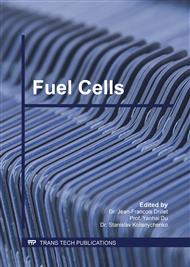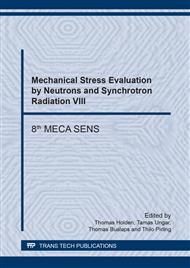p.131
p.137
p.143
p.151
p.157
p.165
p.174
p.182
p.190
Residual Stress Depth Distributions for Atmospheric Plasma Sprayed MnCo1.9Fe0.1O4 Spinel Layers on Crofer Steel Substrate
Abstract:
In solid oxide fuel cells (SOFC) for operating temperatures of 800 °C or below, the use of ferritic stainless steel can lead to degradation in cell performance due to chromium migration into the cells at the cathode side [1]. Application of a coating on the ferritic stainless steel interconnect is one option to prevent Cr outward migration through the coating. MnCo1.9Fe0.1O4 (in the following designated as MCF) spinels act as a diffusion barrier and retain high conductivity during operation [2]. Knowledge about the residual stress depth distribution throughout the complete APS coating system is important and can help to optimize the coating process. This implicitly requires reliable residual stress analysis in the coating, the interface region and in the substrate.For residual stress analysis on these specific layered systems diffraction based analysis methods (XRD) using laboratory X-ray sources can only by applied at the very surface. For larger depths sublayer removal is necessary to gain reliable residual stress data. The established method for sublayer removal is electrochemical etching, which fails, since the spinel layer is inert. However, a mechanical layer removal will affect the local residual stress distribution.As an alternative, mechanical residual stress analyses techniques can be applied. Recently, we established an approach to analyse residual stress depth distributions in thick film systems by means of the incremental hole drilling method [5, 6]. In this project, we refined our approach for the application on MCF coatings with a layer thickness between 60 – 125 μm.
Info:
Periodical:
Pages:
174-181
Citation:
Online since:
August 2017
Authors:
Price:
Сopyright:
© 2017 Trans Tech Publications Ltd. All Rights Reserved
Share:
Citation:



